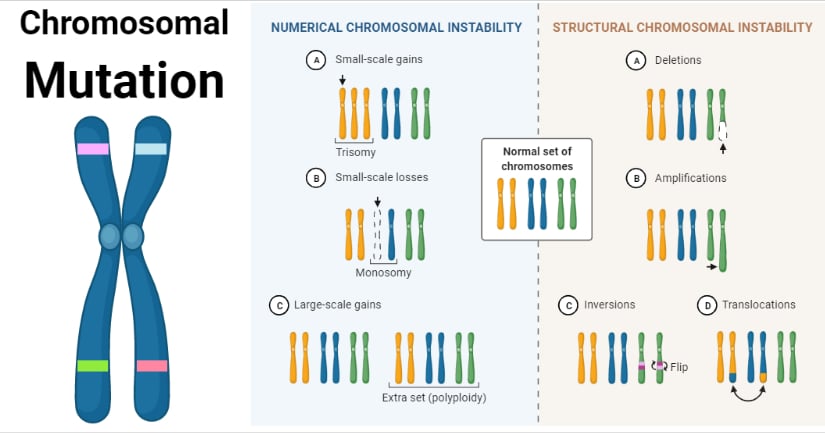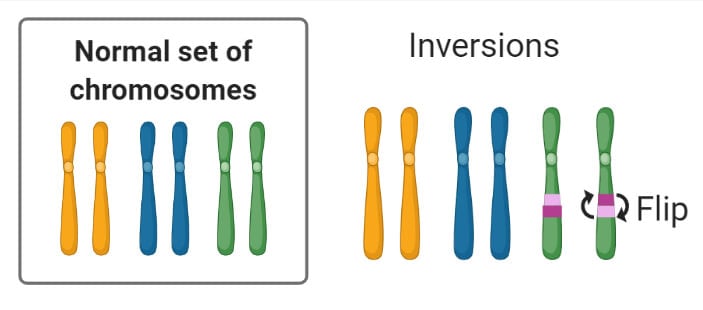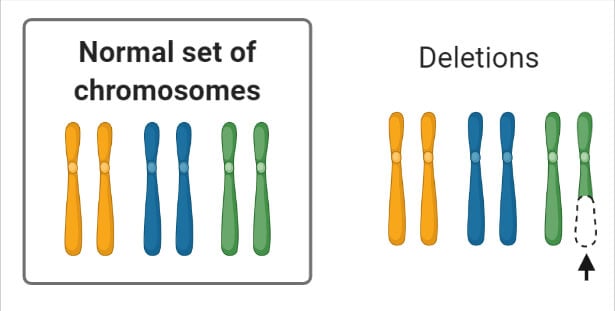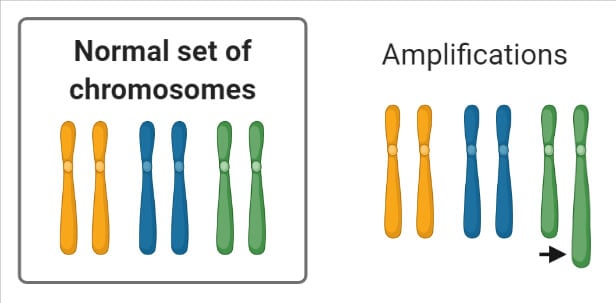Chromosomes are long thread-like structures of DNA that contain part or all of the genetic material of an organism.
- Chromosomes exist in a complex three-dimensional structure which is essential in transcriptional regulation.
- Chromosomes exhibit unique compactness as the unraveled form of the chromosome would be metered in length, but the compact form can be easily placed within the nucleus of a cell.
- Compactness is essential during cell division and in the organization of genetic material.
- The number and structure of chromosomes can be different in different organisms and are often used as a distinguishing feature among different organisms.
- The number of chromosomes in a particular organism is constant and is often used in the determination of phylogeny and taxonomy of the species.
- The shape, structure, and size of the chromosomes are changeable from one phase of cell growth to another during cell growth and cell division.
- The chromosomes in eukaryotic organisms are condensed with packaging proteins called histones and chaperone proteins. These proteins bind the chromosomes and condense the DNA molecules into the thread-like structures.
- A single chromosome is found in prokaryotic cells, which are not enclosed with a nuclear membrane and remain free in the cytoplasm. There are no packaging proteins bound to the chromosomes.
- Chromosomes, thus, are sensitive structures that are essential for all the functions of the living system. Any change in the chromosomes can bring mild to severe changes in the structure and function of the organism.
Interesting Science Videos
Chromosomal Mutation Definition
The chromosomal mutation is the process of change in the chromosomes as a result of rearranged chromosome parts and changes in the number of individual chromosomes or chromosome set present in the genome.
- Chromosome mutations can be detected either by microscopic examinations or genetic analysis, or both. This distinguishes chromosomal mutations from gene mutations that cannot be detected microscopically.
- Chromosomal mutations are the result of certain accidents or irregularities in the chromosomes at the time of cell division, crossing over, or fertilization. These incidents cause alterations in the morphology and number of chromosomes.
- Chromosomal mutations are also called chromosomal aberrations, chromosomal abnormality, or chromosomal disorders, all indicating a possible alteration in the morphology and structure of the chromosome.
- Chromosomal mutations lead to abnormalities in the function of the cell and organism, as chromosomal mutations can result in abnormal gene numbers or positions.
- These are known to cause different genetic diseases that can be hereditary and are transferred from one generation to another.
- These mutations, however, do not always affect the functioning of the cell as some mutations might affect regions of chromosomes that do not make up the genetic makeup of the organism.
- Even though gene mutations are usually more severe than chromosomal mutations, some chromosomal mutations might result in gene mutations.

Causes of Chromosomal Mutation
- Chromosomal mutations take place either due to the changes in the structure of the chromosomes or due to the abnormality in the chromosome number.
- In both of the cases, the most important cause includes the mistakes during chromosome division or crossing over.
- Some portions of chromosomes might lag during anaphase, which causes them to be lost during nuclei reorganization. Some might even be digested by nucleases.
- In the case of duplication, a portion or the entire chromosome might be duplicated as a result of some mistake during chromosome division.
- Most of the structural mutations occur at crossing over, where the abnormal breaking or separation of the chromosome can result in chromosomal mutations.
- In the case of numerical mutations, irregularities in nuclear division or accidents or mutagens can change the genomes of the cells.
- The formation of aberrant genomes in living organisms is caused by irregularities during meiosis. These can occur either naturally or are generated artificially.
- Mutagens like radiation and chemical molecules might also be involved in chromosomal mutations.
- Chromosomal mutations are hereditary if present in the heritable part of the chromosomes and thus can be passed down from one generation to the other.
- Depending on the cause, extent, and position of the mutation, chromosomal mutations can produce a wide range of effects in the organisms.
Mechanism of Chromosomal Mutation
- The mechanism involved in the chromosomal mutation depends on the type of mutation.
- Changes in the structure of the chromosome occur due to various mistakes or accidents during the nuclear organization. The loss of chromosome sections is also caused by the digestion of those sections by nucleases.
- Changes in the number of chromosomes occur due to abnormal pairing or the lag during the cell cycle. The paired chromosomes in some cells might not be separated during anaphase leading to the addition and loss of chromosomes.
- Besides, induced chromosomal mutations can also occur as a result of exposure to physical agents like radiation and chemical molecules.
- The overall effect of the mutation also depends on the type of mutation and the mechanism involved in it.
Types of Chromosomal Mutation
Chromosomal mutations can be broadly categorized into two groups; chromosomal mutations I and chromosomal mutations II.
1. Chromosomal Mutations I
Chromosomal mutations I include structural mutations that arise as a result of alterations in the structure of the chromosomes. Structural changes in chromosomes usually occur due to the property of the chromosomes to form pairing and undergo contortions, as well as due to the tendency to break and form sticky ends. Structural mutations are further divided into different types depending on the mechanism of the process;
a. Inversion
- Inversion is a type of structural mutation where a part of chromosomes or a set of genes rotates by 180° on its own axis.
- There is no net loss or gain of genes but simply a rearrangement of the sequence. A part of the chromosome is broken and then rejoined in a different direction.
- Inversion mutation can be detected cytologically in the meiotic nuclei by the detection of an inversion loop in the paired homologs.
- The genetic behavior of the changed chromosome depends on the location of the centromere from the site of inversion.
- If the inversion doesn’t include the centromere, it is called paracentric inversion, while if the centromere is included, it is called pericentric inversion.
- If identical inversion occurs in each member of the homologous chromosome, normal distribution of the chromosome occurs. However, inversion heterozygotes might produce deletions and duplication during crossing over.

Examples of Inversion
- An example of chromosomal inversion can be observed in the insect, Coelopa frigid, where the chromosomal inversion results in the production of differences in phenotype.
- Chromosomal inversion occurs only in the larger species as the smaller species cannot survive the mutation.
- The changes observed as a result of the mutation are a three-fold difference in size in males. The change heterokaryotype has higher viability than the original structure.
- Thus, inversion mutation in the species acts as an evolutionary asset in the species, which increases its fitness in the ecosystem.
b. Deletion
- Deletion is a type of structural mutation that occurs due to the loss of a part of a chromosome as a result of the breakage of the chromosome.
- The deletion occurs due to the loss of a portion of a chromosome, usually due to lag during anaphase and digestion by nucleases.
- Chromosomes that have undergone deletion cannot revert back to normal and, if transmitted to the next generation, can be hereditary.
- Deletion can either be terminal or intercalary. The terminal deletion occurs due to the loss of the terminal section of a chromosome. This involves a single break n the chromosome.
- The intercalary deletion occurs due to the loss of an intermediate section of the chromosome. This involves two breaks on either end of the deleted section.
- Deletion is lethal in the case of homozygous chromosomes, and even in heterozygous chromosomes, there are slim chances of survival. Heterozygous chromosomes can, however, survive smaller deletion.

Examples of Deletion
- Deletion of the short arm of chromosome 5 in humans results in a distinctive cat-like cry in babies.
- It is also known as the French name ‘cri du chat’ syndrome, indicating the cat-like cry.
- These individuals tend to be mentally slow with an IQ below 20 and have different forms of malformation in the larynx, moon faces, saddle noses, and small mandibles.
- The syndrome can be inherited from one generation to another can might even affect the ears and the size of the head.
c. Duplication/Amplifications
- Duplication is a type of structural mutation where a part of a chromosome is present in excess of the normal composition.
- The genes present in a cell might exist in more than two doses as a result of duplication.
- When the duplication is present in only one of the two homologous chromosomes, the chromosome with the supplicated segment forms a loop to match the position of the homologous regions.
- Duplication in the chromosome can occur in multiple ways; tandem duplication, reverse tandem duplication, displaced duplication, transposed duplication, and extra-chromosomal duplication.
- Tandem duplication occurs when the duplicated region is present just beside the normal corresponding section of the chromosome.
- Reverse tandem duplication occurs when the sequence of genes in the duplicated region is just the reverse of the normal sequence.
- In displaced duplication, the duplicated region is not situated next to the normal section.
- When the duplicated regions become attached to a different nonhomologous chromosome, it is called transposed duplication.
- An extra-chromosomal duplication is formed when the duplicated part has a centromere, resulting in an independent chromosome.

Examples of Duplication/Amplifications
- The duplication of a segment of the X-chromosome, called section 16A, in Drosophila is a classic example of duplication.
- Section 16A codes for the bar trait in Drosophila, which is characterized by a narrower, oblong, bar-shaped eye with a few facets.
- Each duplicated section 16A intensifies the bar phenotype, which increases the narrowing effect.
- The duplication of the section acts as a genetically dominant factor, and the phenotype intensifies if the duplicated genes occur on the same chromosome.
d. Translocation
- Translocation is a type of structural mutation resulting from the shift or transfer of a part of a chromosome or a set of genes to a nonhomologous chromosome.
- There is no net gain or loss of chromosomes or genes during translocation but a rearrangement.
- There are three different types of translocations depending on the pattern of rearrangement; simple translocation, shift translocation, and reciprocal translocation.
- Simple translocation involves a single break in the chromosome where the broken piece then attaches to one of the ends of a nonhomologous chromosome.
- Shift translocation involves the insertion of a broken segment of a chromosome interstitially in a nonhomologous chromosome.
- Reciprocal translocation is the exchange of a translocated segment with another in order to create two translocated chromosomes.
- The exchange of chromosome sections between nonhomologous chromosomes generates new linkages with possible new phenotypes.

Examples of Translocation
- A rare series of reciprocal translocation can be observed in Oenothera involving all 7 of the chromosome pairs.
- Multiple translocations exist within the set, which produces different lethal combinations.
- The translocation results in a ring-like structure of the chromosome where the gametes usually do not survive the mutation.
- Viable gametes are formed only when the linkages are alternate disjunction from the ring structure.
2. Chromosomal Mutations II
Chromosomal mutations II include mutations that are caused by the alterations in the number of chromosomes in a cell. The change in the number of whole chromosomes is called heteroploidy. It produces phenotypic changes, modifications of phenotypic ratios, and alteration of linkage groups. Heteroploidy can be further divided into two different categories depending on the changes in the entire set of chromosomes or in the single whole chromosome.

a. Aneuploidy
- Aneuploidy is a type of mutation that changes parts of a chromosome set, resulting in either the loss of one or more chromosomes or the addition of chromosomes.
- Aneuploidy resulting from the loss of chromosomes is called hypoploidy, whereas that due to the addition of chromosomes is called hyperploidy.
- Hypoploidy usually occurs due to the loss of a single chromosome (monosomy) or due to the loss of a pair of chromosomes (nullisomy).
- Hyperploidy, in turn, might involve the addition of a single chromosome (trisomy) or the addition of a pair of chromosomes (tetrasomy).
- Aneuploids are caused as a result of nondisjunction during mitosis or meiosis.
- If aneuploidy occurs in the gametes of plants, those do not survive, but in animals, some genetic imbalance leading to higher mortality or reduced fertility might occur.
Examples of Aneuploidy
- Down’s syndrome is an example of aneuploidy which is associated with a trisomic condition for one of the smallest human autosomes (chromosome no. 21).
- Down’s syndrome is the most common chromosomal abnormality in live births and exhibits 50 different physical characteristics.
- The characteristics can range from mild and moderate mental retardation to internal epicanthal folds and swollen tongue.
- The main cause of the trisomy is the nondisjunction of chromosome 21 during oogenesis. Down syndrome in children can also occur due to nondisjunction chromosome pairs in spermatogenesis.
b. Polyploidy
- Polyploidy is a type of euploidy (changes in the entire set of chromosomes) where an organism has more than two sets of genomes (2x).
- Polyploidy includes different combinations like triploid, tetraploid, pentaploid, hexaploid, and octoploid.
- Polyploidy higher than tetraploid is not common in natural environments, but it can be observed in some crops and ornamental flowers.
- Polyploidy can be further divided into three groups; autopolyploids, allopolyploids, and autoallopolyploids.
- Autopolyploids are polyploids that consist of the same basic set of chromosomes but multiplied to form multiple sets.
- Allopolyploids are the polyploids that result from the doubling of chromosome number in a hybrid from two different species.
- The most common morphological effect of polyploidy is gigantism that is commonly seen in large-sized pollen and cells. Besides, it also reduces the fertility of plants to varying degrees.
Examples of Polyploidy
- An example of polyploidy can be observed in ‘doob’ grass (Cynodon dactlylon) which is mostly cultivated in South Asia.
- It is triploid and sterile but can be propagated vegetatively. Polyploidy results in large-sized plants that have decreased osmotic pressure with increased water content.
- The rate of cell division is low, and thus, the plant growth rate also decreases. These also have reduced auxin content which decreases their rate of respiration.
Applications of Chromosomal Mutation
Chromosomal mutations have different applications in different branches of biology, some of which are;
- The mutations can be used as a method of designing special arrangements of genes uniquely to solve different biological issues.
- Chromosomal mutations are also essential at the applied level in medicine, plant, and animal breeding.
- These mutations play an important role in the evolutionary process by shaping the genomes and chromosomes of different organisms.
- Induced polyploidy has been used to produce seedless fruits and vegetables. Monoploidy facilitates genetic experiments as all the genes in a monoploid are expressed.
- Chromosomal mutations can be adopted as a form of molecular therapy to treat different genetic and hereditary diseases.
References
- Verma PS and Agarwal VK (3005). Cell Biology, Genetics, Molecular Biology, Evolution, and Ecology. Multicoloured Edition.
- Griffiths AJF, Miller JH, Suzuki DT, et al. An Introduction to Genetic Analysis. 7th edition. New York: W. H. Freeman; 2000. Introduction. Available from: https://www.ncbi.nlm.nih.gov/books/NBK22086/
- Griffiths AJF, Gelbart WM, Miller JH, et al. Modern Genetic Analysis. New York: W. H. Freeman; 1999. Chapter 8, Chromosome Mutations. Available from: https://www.ncbi.nlm.nih.gov/books/NBK21259/
- Griffiths AJF, Gelbart WM, Miller JH, et al. Modern Genetic Analysis. New York: W. H. Freeman; 1999. Chromosomal Rearrangements. Available from: https://www.ncbi.nlm.nih.gov/books/NBK21367/
- Berdan, E., Rosenquist, H., Larson, K. et al. Inversion frequencies and phenotypic effects are modulated by the environment: insights from a reciprocal transplant study in Coelopa frigida. Evol Ecol 32, 683–698 (2018). https://doi.org/10.1007/s10682-018-9960-5

thank you for this useful knowledge and information!
Its wonderful thanks